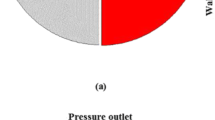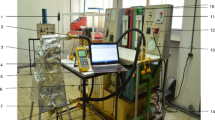Abstract
The present numerical study addresses the buoyancy assisted transient two-dimensional early-stage heat transfer and melting process of PCM’s in a square enclosure. Two PCM materials are used namely pure paraffin wax and paraffin with 1 mass % fraction of SiC nano particles. The square enclosure walls are subjected to a constant temperature of 65 °C (Hot wall) and 27 °C (Cold wall) at bottom and top side, respectively, while remaining sides of the enclosure are perfectly insulated. A finite volume (FVM)-based Ansys fluent software along with enthalpy-porosity method is used to capture the phase change process from solid to liquid. The pressure–velocity coupling is performed by coupled scheme, while pressure correction is done by PRESTO method. The transient variation of PCM liquid fraction, temperature, velocity and enthalpy are plotted. The results obtained shows that a notable difference is confined between early melting stages of both paraffin and nano-enhanced paraffin materials. The close observation of velocity vectors clearly shows that the addition of SiC nanoparticles in pure paraffin improves the convective heat transfer rate with time. The addition of SiC nano particles in paraffin reduces the melting time of paraffin but contrary influence the uniformity in temperature distribution and heat transfer characteristics. The presence of SiC nanoparticles increases the liquid fraction and temperature rise by 33% as compared with pure paraffin.








Similar content being viewed by others
Abbreviations
- V :
-
Fluid velocity (m s−1)
- K t :
-
Thermal conductivity (W m−1 °C−1)
- C p :
-
Specific heat at constant pressure (J kg−1 °C−1)
- E s :
-
Specific enthalpy (J kg−1)
- E sen :
-
Sensible enthalpy (J kg−1)
- L h :
-
Latent heat (J kg−1)
- S :
-
Momentum source term
- E r :
-
Reference enthalpy (J kg−1)
- T :
-
Temperature (°C)
- T r :
-
Reference temperature (°C)
- T h :
-
Hot wall temperature (°C)
- T c :
-
Cold wall temperature (°C)
- T sd :
-
Solidus temperature (°C)
- T lq :
-
Liquidus temperature (°C)
- T am :
-
Average melting temperature (°C)
- T avg :
-
Area weighted average temperature (°C)
- t :
-
Time (s)
- H :
-
Height of the enclosure (mm)
- Ra :
-
Rayleigh number
- g :
-
Acceleration due to gravity (m s−2)
- q wall :
-
Wall heat flux (W m−2)
- M Z :
-
Mushy zone constant
- PRESTO :
-
Pressure staggering option
- PCM :
-
Phase change material
- SiC :
-
Silicon carbide
- P 1 :
-
Paraffin wax
- P 2 :
-
Paraffin with 1% mass fraction of SiC
- µ :
-
Dynamic viscosity (Pa.s)
- ρ :
-
Density (kg m−3)
- ω :
-
Constant
- γ :
-
Thermal diffusivity (m2 s−1)
- α :
-
Melted liquid fraction
- \(\vartheta\) :
-
Kinematic viscosity (m2 s−1)
- r:
-
Reference
- h:
-
Hot
- c:
-
Cold
- sd:
-
Solidus
- lq:
-
Liquidus
- am:
-
Average melting
- avg:
-
Average
- s:
-
Specific
- sen:
-
Sensible
References
Kamkari B, Shokouhmand H. Experimental investigation of phase change material melting in rectangular enclosures with horizontal partial fins. Int J Heat Mass Transf. 2014;78:839–51. https://doi.org/10.1016/j.ijheatmasstransfer.2014.07.056.
Archibold AR, Rahman MM, Goswami DY, Stefanakos EK. Analysis of heat transfer and fluid flow during melting inside a spherical container for thermal energy storage. Appl Therm Eng. 2014;64:396–407. https://doi.org/10.1016/j.applthermaleng.2013.12.016.
Tan FL, Hosseinizadeh SF, Khodadadi JM, Fan L. Experimental and computational study of constrained melting of phase change materials (PCM) inside a spherical capsule. Int J Heat Mass Transf. 2009;52:3464–72. https://doi.org/10.1016/j.ijheatmasstransfer.2009.02.043.
Seddegh S, Wang X, Henderson AD. A comparative study of thermal behaviour of a horizontal and vertical shell-and-tube energy storage using phase change materials. Appl Therm Eng. 2016;93:348–58. https://doi.org/10.1016/j.applthermaleng.2015.09.107.
Sharma A, Tyagi VV, Chen CR, Buddhi D. Review on thermal energy storage with phase change materials and applications. Renew Sustain Energy Rev. 2009;13:318–45. https://doi.org/10.1016/j.rser.2007.10.005.
Himran S, Suwono A, Mansoori GA. Characterization of alkanes and paraffin waxes for application as phase change energy storage medium. Energy Sources. 1994;16:117–28. https://doi.org/10.1080/00908319408909065.
Abhat A. Low temperature latent heat thermal energy storage: heat storage materials. Sol Energy. 1983;30:313–32. https://doi.org/10.1016/0038-092X(83)90186-X.
Chaichana MT, Kazem HA. Single slope solar distillator productivity improvement using phase change material and Al2O3 nanoparticle. Sol Energy. 2018;164:370–81.
Khodadadi JM, Hosseinizadeh SF. Nanoparticle-enhanced phase change materials (NePCM) with great potential for improved thermal energy storage. Int Commun Heat Mass Transfer. 2007;34:534–43.
Eanest Jebasingh B, Valan Arasu A. A comprehensive review on latent heat and thermal conductivity of nanoparticle dispersed phase change material for low temperature applications. Energy Storage Mater. 2020;24:52–74. https://doi.org/10.1016/j.ensm.2019.07.031.
Gao JW, Zheng RT, Ohtani H, Zhu DS, Chen G. Experimental investigation of heat conduction mechanisms in nanofluids. Clue on clustering. Nano Lett. 2009;9:4128–32. https://doi.org/10.1021/nl902358m.
Sheikholeslami M. Solidification of NEPCM under the effect of magnetic field in a porous thermal energy storage enclosure using CuO nanoparticles. J Mol Liq. 2018;263:303–15. https://doi.org/10.1016/j.molliq.2018.04.144.
Fan L, Khodadadi JM. An experimental investigation of enhanced thermal conductivity and expedited unidirectional freezing of cyclohexane-based nanoparticle suspensions utilized as nano-enhanced phase change materials (NePCM). Int J Therm Sci. 2012;62:120–6. https://doi.org/10.1016/j.ijthermalsci.2011.11.005.
Sarafraz MM, Christo FC. Phase change heat transfer induced by plasmon heat generation in liquid micro-layer inside a micro reactor. J Energy Storage 2021;42:103033.
Shahsavar A, Khanmohammadi S, Karimipour A, Goodaarzi M. A novel comprehensive experimental study concerned synthesizes and prepare liquid paraffin-Fe3O4 mixture to develop models for both thermal conductivity and viscosity: a new approach of GMDH type of neural network. Int J Heat Mass Transf. 2019;131:432–41.
Sarafraz MM, Safaei MR, Goodarzi M, Yang B, Arjomandi M. Heat Transfer analysis of Ga-In-Sn in a compact heat exchanger equipped with straight micro passages. Int J Heat Mass Transf. 2019;139:675–84.
Sarafraz MM, Baghi AD, Safaei MR, Leon AS, Ghomaschi R, Goodarzi M, Lin CX. Assesment of Iron oxide (III) therminol-66 nanofluid as a Novel working fluid in a convective radiator heating system for buildings. Energies 2019;12:4327. https://doi.org/10.3390/en12224327.
Iachachene F, Haddad Z, Oztop HF, Abu-Nada E. Melting of phase change materials in a trapezoidal cavity: orientation and nanoparticles effects. J Mol Liq. 2019. https://doi.org/10.1016/j.molliq.2019.03.051.
Fadl M, Eames PC. Numerical investigation of the influence of mushy zone parameter Amush on heat transfer characteristics in vertically and horizontally oriented thermal energy storage systems. Appl Therm Eng. 2019;151:90–9.
Ebrahimi A, Dadvand A. Simulation of melting of a nano-enhanced phase change material (NePCM) in a square cavity with two heat source–sink pairs. Alex Eng J. 2015;54:1003–17.
Assis E, Katsman L, Ziskind G, Letan R. Numerical and experimental study of melting in a spherical shell. Int J Heat Mass Transf. 2007;50:1790–804.
Regin AF, Solanki SC, Saini JS. Latent heat thermal energy storage using cylindrical capsule: numerical and experimental investigations. Renew Energy. 2006;31:2025–41.
Shokouhmand H, Kamkari B. Experimental investigation on melting heat transfer characteristics of lauric acid in a rectangular thermal storage unit. Exp Ther Fluid Sci. 2013;50:201–12.
Brent AD, Voller VR, Reid KJ. Enthalpy-Porosity Technique for modeling convection-diffusion phase change: application to melting of a pure metal. Numer Heat Transf. 1988;13:297–318.
Vogel J, Felbinger J, Jhonson M. Natural Convection in High Temperature Flat Plate latent heat thermal energy storage system. Appl Energy. 2016;184:184–96.
Maher H, Rocky KA, Bassiouny R, Saha BB. Synthesis and thermal characterization of paraffin-based nanocomposites for thermal energy storage applications. Ther Sci Eng Prog. 2020. https://doi.org/10.1016/j.tsep.2020.100797.
Jilte R, Afzal A, Panchal S. A novel battery thermal management system using nano-enhanced phase change materials. Energy. 2021;219: 119564. https://doi.org/10.1016/j.energy.2020.119564.
Jilte R, Afzal A, Islam MT, Manokar AM. Hybrid cooling of cylindrical battery with liquid channels in phase change material. Int J Energy Res. 2021. https://doi.org/10.1002/er.6590.
Afzal A, Mokashi I, Khan SA, NAA, Muhammad Azami Bin H. Optimization and analysis of maximum temperature in a battery pack affected by low to high Prandtl number coolants using response surface methodology and particle swarm optimization algorithm. Numer Heat Transf Part A Appl. 2020;0:1–30. https://doi.org/10.1080/10407782.2020.1845560.
Mokashi I, Afghan S, Nur, Abdullah A, Hanafi, Muhammad Azami B, Afzal A. Maximum temperature analysis in a Li‑ion battery pack cooled by different fluids. J Therm Anal Calorim. 2020;1–17. https://doi.org/10.1007/s10973-020-10063-9.
Upender H, Kishore KA, Afzal A, Islam MT, Ibrahim M. Mean residence time and mass fraction of tracer in a liquid-solid tapered inverse fluidized bed: numerical modelling with experimental validation. J Taiwan Inst Chem Eng. 2021;000:1–11. https://doi.org/10.1016/j.jtice.2021.09.004.
Sari A, Karaipekli A. Thermal conductivity and latent heat thermal energy storage characteristics of paraffin/expanded graphite composite as phase change material. Appl Therm Eng. 2007;27:1271–7. https://doi.org/10.1016/j.applthermaleng.2006.11.004.
Acknowledgement
The author extends his appreciation to the Deanship of Scientific Research at King Khalid University, Saudi Arabia for funding this work through the Research Group Program under Grant No: RGP 2/26/43.
Author information
Authors and Affiliations
Corresponding author
Additional information
Publisher's Note
Springer Nature remains neutral with regard to jurisdictional claims in published maps and institutional affiliations.
Rights and permissions
About this article
Cite this article
Saleel, C.A. Numerical study on melting and heat transfer characteristics of paraffin wax/ SiC paraffin using enthalpy-porosity model. J Therm Anal Calorim 147, 10497–10508 (2022). https://doi.org/10.1007/s10973-022-11265-z
Received:
Accepted:
Published:
Issue Date:
DOI: https://doi.org/10.1007/s10973-022-11265-z




